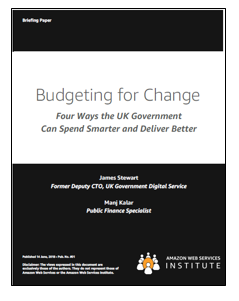AWS Public Sector Blog
Budgeting for Change: How Can Government Spend Smarter and Deliver Better?
The UK Government has made strides toward a digital evolution. Thanks to the spending controls and service re-design introduced by the Government Digital Service as part of its digital transformation effort, £3.56bn were saved between 2012-2015.
Still, Government must look to remove structural, operational, and cultural barriers to technology adoption to experience the numerous benefits of a digital transformation. As Yvonne Gallagher, Director of Digital Value for Money, at the UK National Audit Office put it: “We need to get to the bottom of what transformation is to manage it well. Sometimes it’s called transformation but it actually means cost-cutting.”
The AWS Institute, with the Institute for Government, convened a working group of Government leaders earlier this year to dive deep into this challenge. The group concluded that the UK should use its upcoming 2019 Spending Review to make the changes it needs to realize the full potential of this digital journey.
So, the AWS Institute teamed up with James Stewart, co-founder of the UK Government Digital Service and Deputy CTO of UK Government, and Manj Kalar, a public finance specialist, to turn this dialogue into actionable ideas. See their four recommendations below on “Budgeting for Change: Four Ways the UK Government Can Spend Smarter and Deliver Better,” which they discussed at the Institute for Government and will discuss next week at the AWS Public Sector Summit.
- Her Majesty’s Treasury (HMT) should empower accounting officers (AOs) to reallocate planned capital expenditure for digital technology to operating spend. Current budgetary controls only allow AOs to move from revenue to capital. The opposite should also be possible: AOs should be able to move budgets from capital to revenue within the total spending allocation – when they can justify that a decision delivers long-term savings, rather than compliance with rules. A modest boost to opex can help the government deliver significantly more value to citizens.
- Government should innovate via “safe pilots” for smarter spending. Developed and delivered jointly by HMT and National Audit Office (NAO), teams responsible for specific government services, these experiments would help identify ways to innovate with technology during the lifespan of existing contracts, optimizing operations and maximizing value.
- The Treasury should launch a “Centre of Excellence for Smarter Spending.” This Centre of Excellence (CoE) would consist of a cross-functional team of Treasury officials, auditors, developers, and program managers, tasked to develop and deliver a strategy for smarter spending enabled by technology, and to identify best practices. The CoE would be in charge of the experimental pilots (per recommendation 2 above), including a full digitalization of the Online System for Central Accounting and Reporting, which provides key management information and data for public reporting.
- The Government Digital Service should update its forecast of savings from digital transformation – and account for the cost of legacy IT systems and contracts. Today, the UK Government does not account for the costs and risks of technical debt, with its last Digital Efficiency Report published in 2012. As the government prepares to review its spending, it should develop a methodology to assess the costs of maintaining its current technology footprint, versus the benefits of investing in flexible, on-demand technologies like the cloud.
As time passes and budgetary pressure mounts, digital transformation becomes an ever-greater financial opportunity for government – and the citizens it serves. Read the AWS Institute briefing paper.
